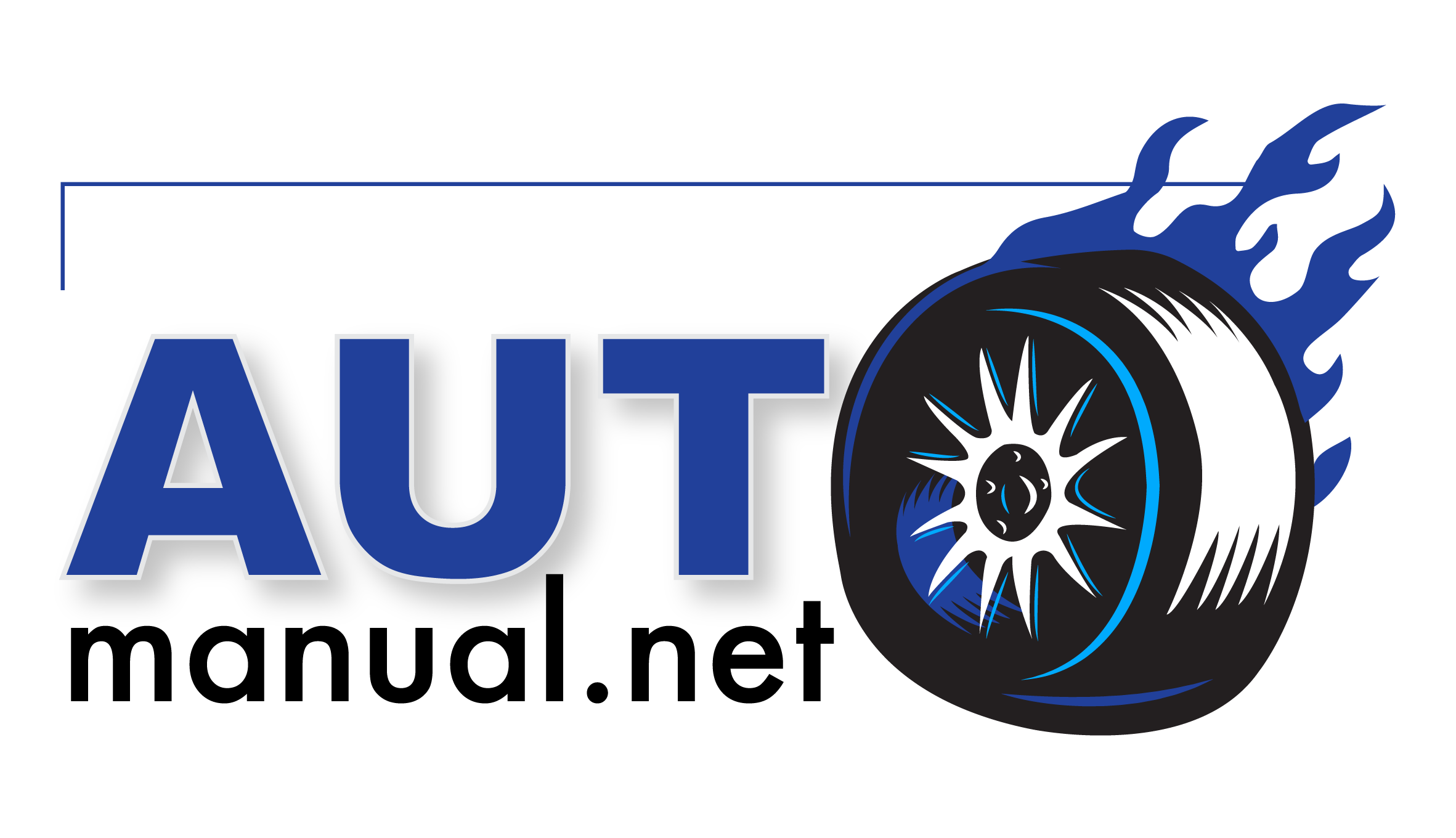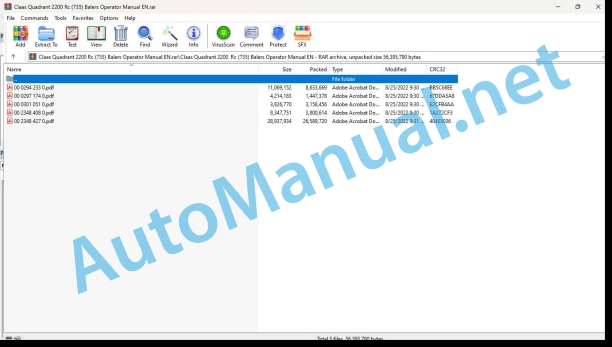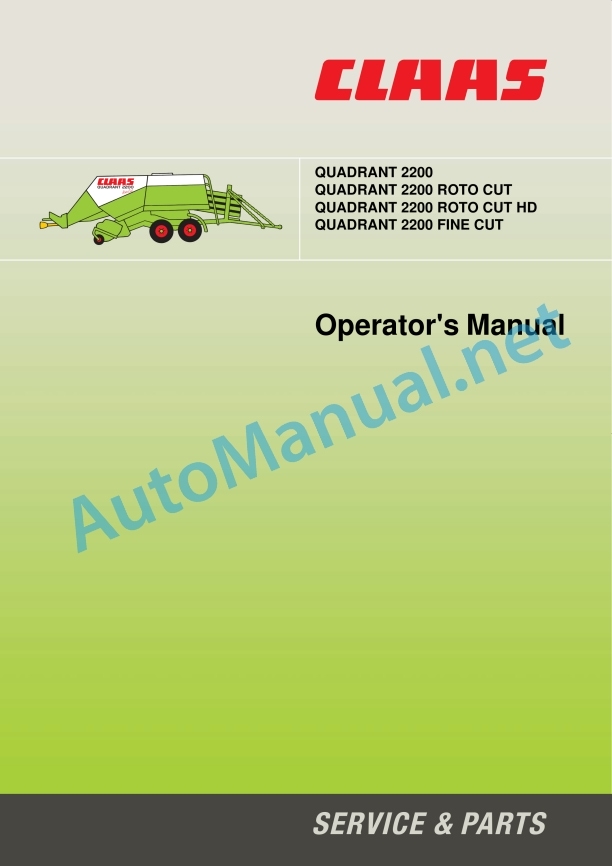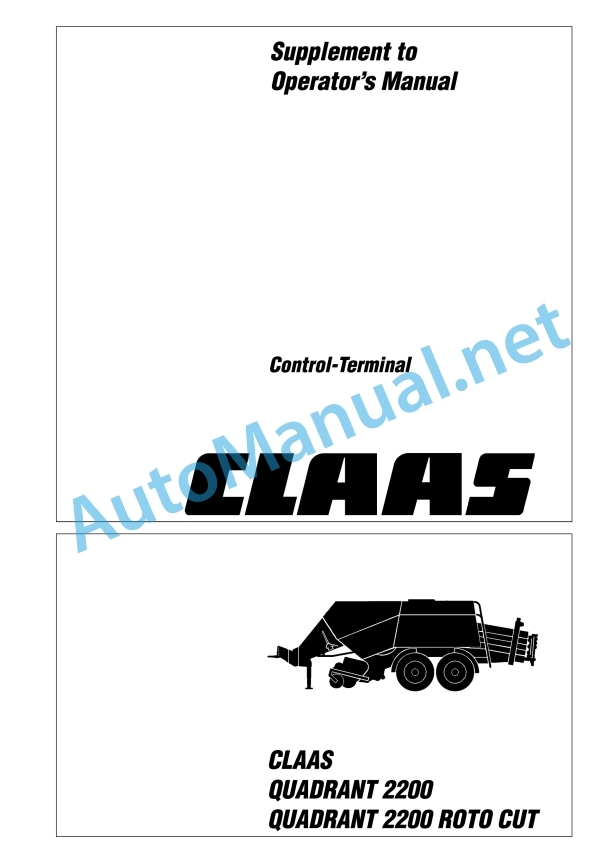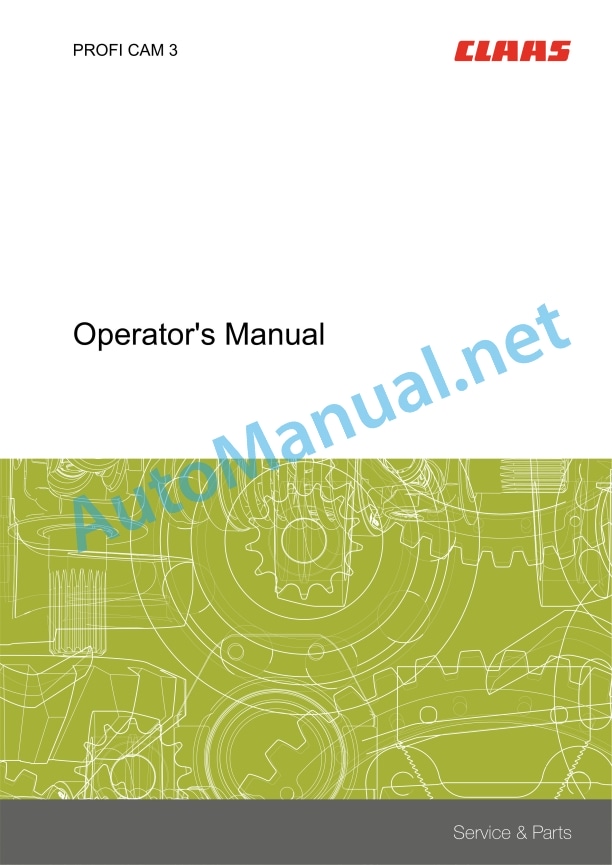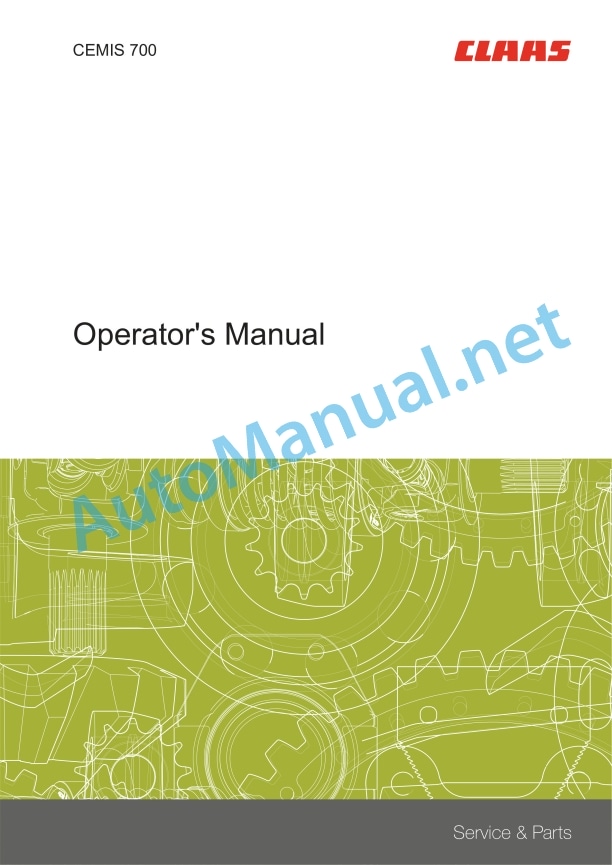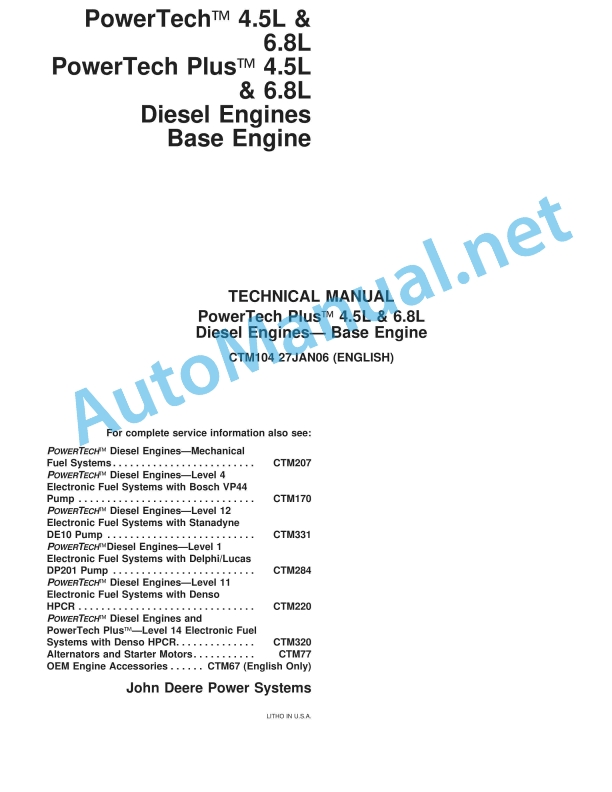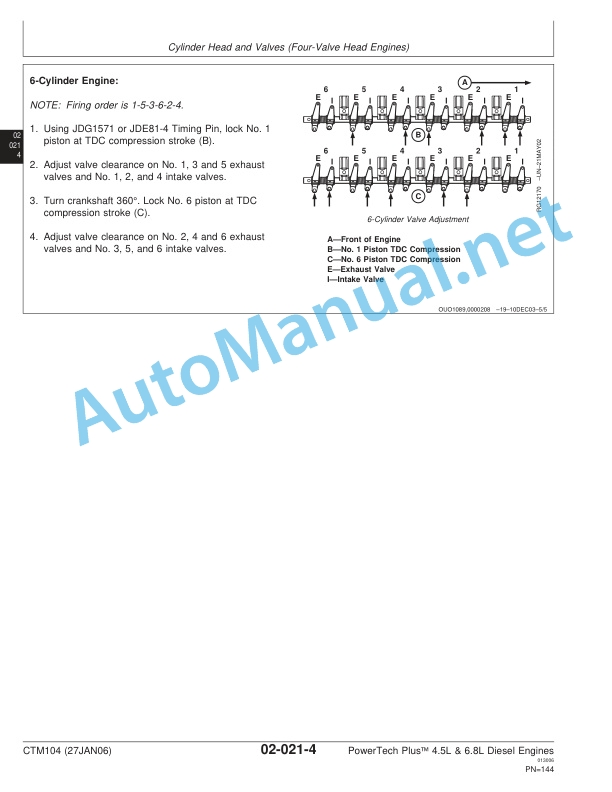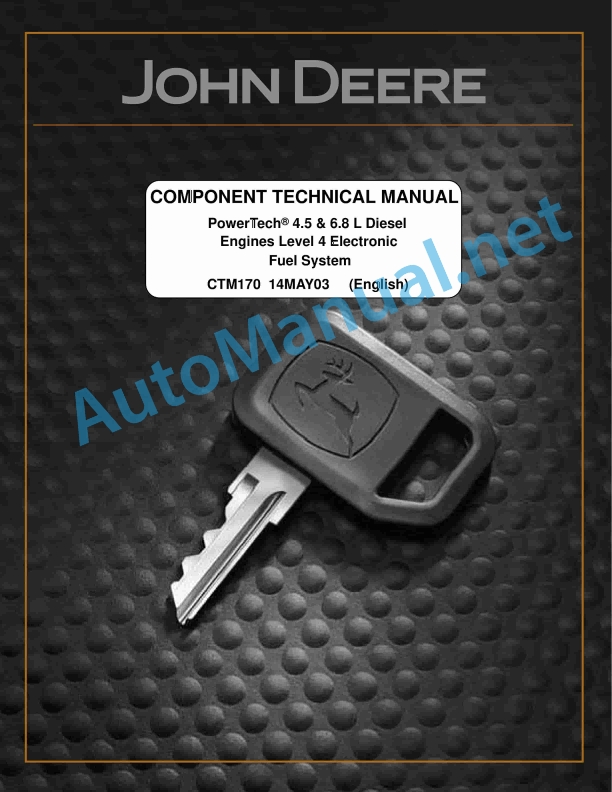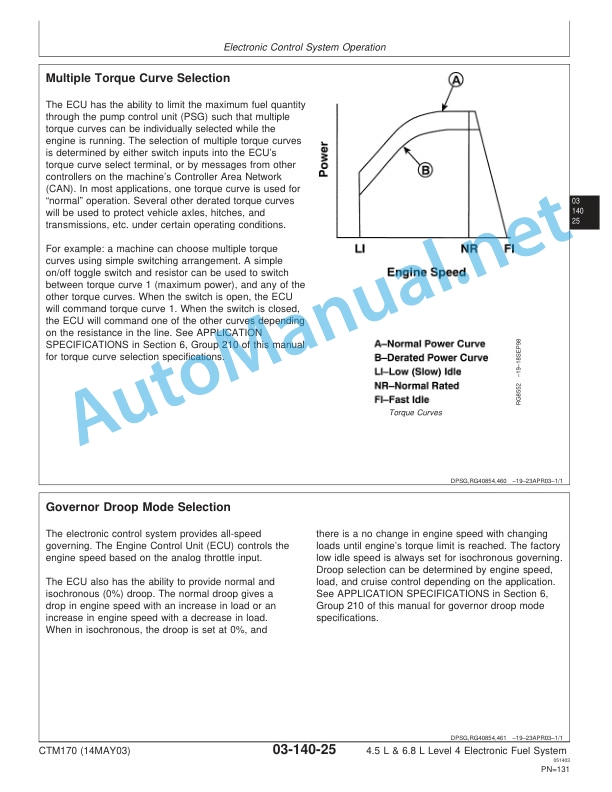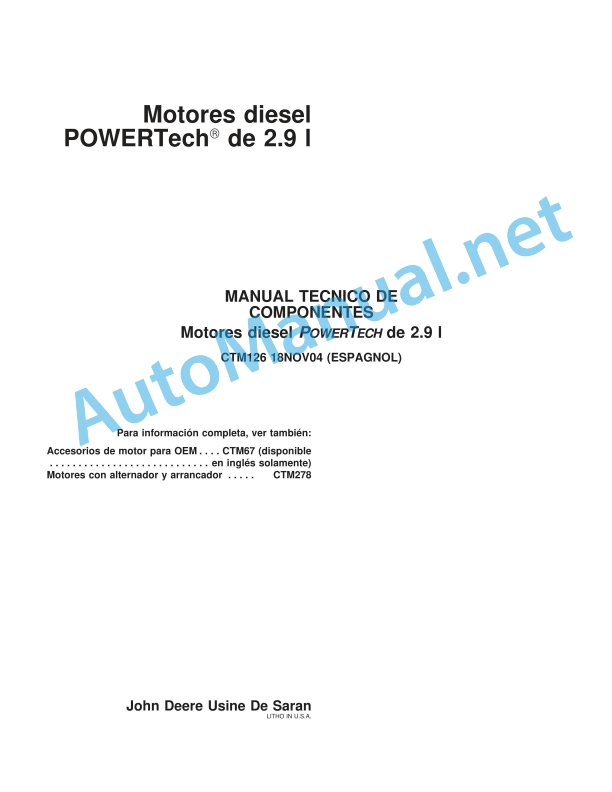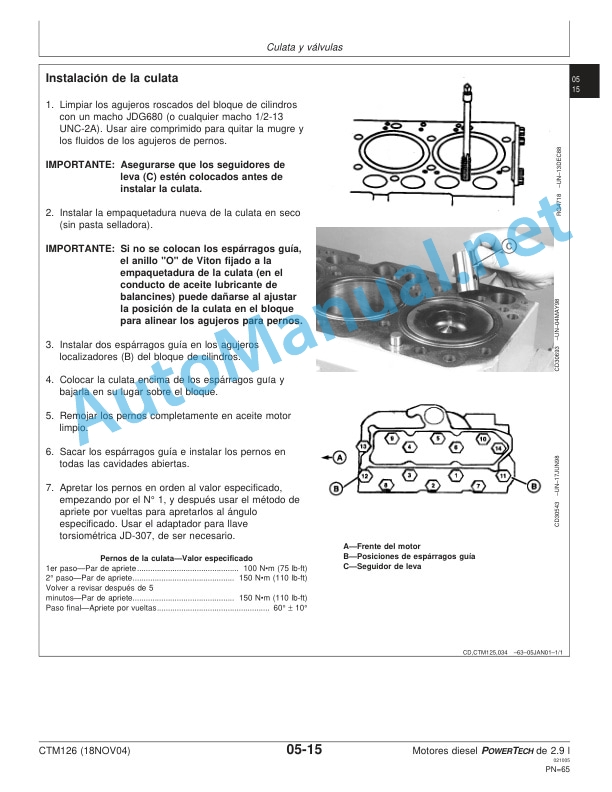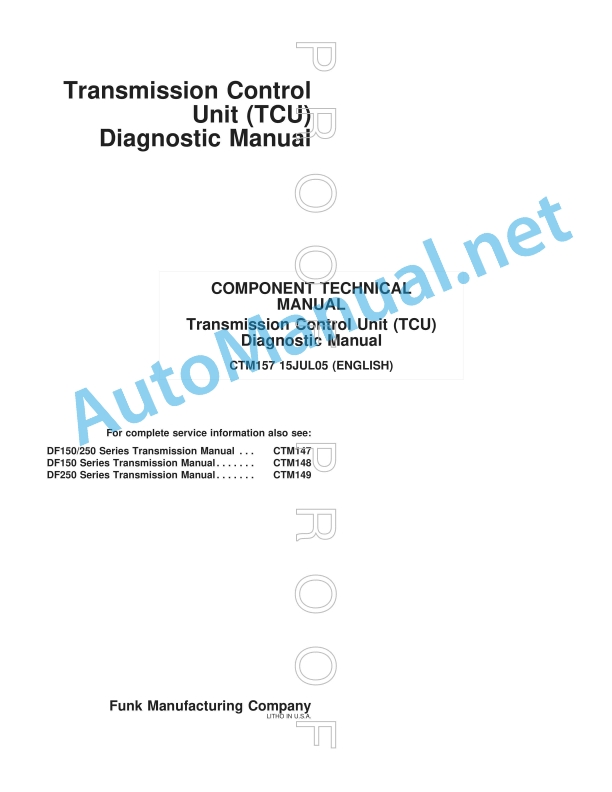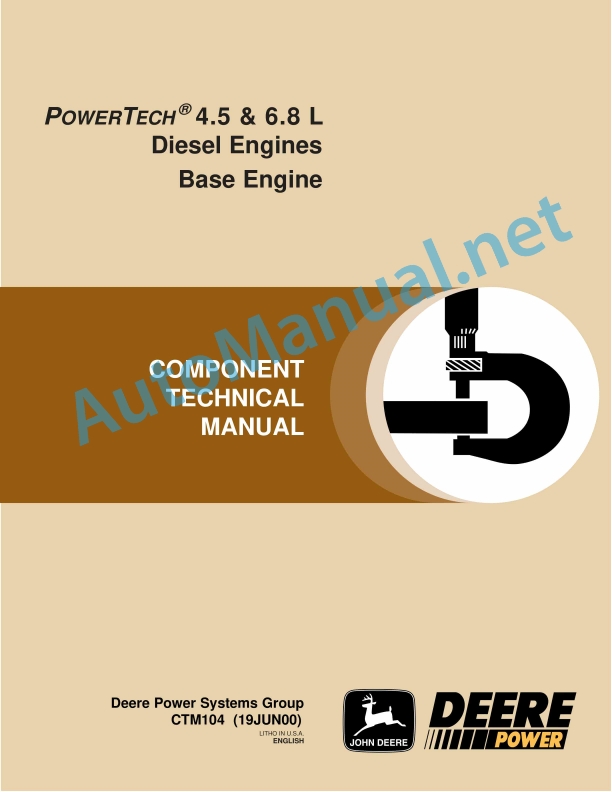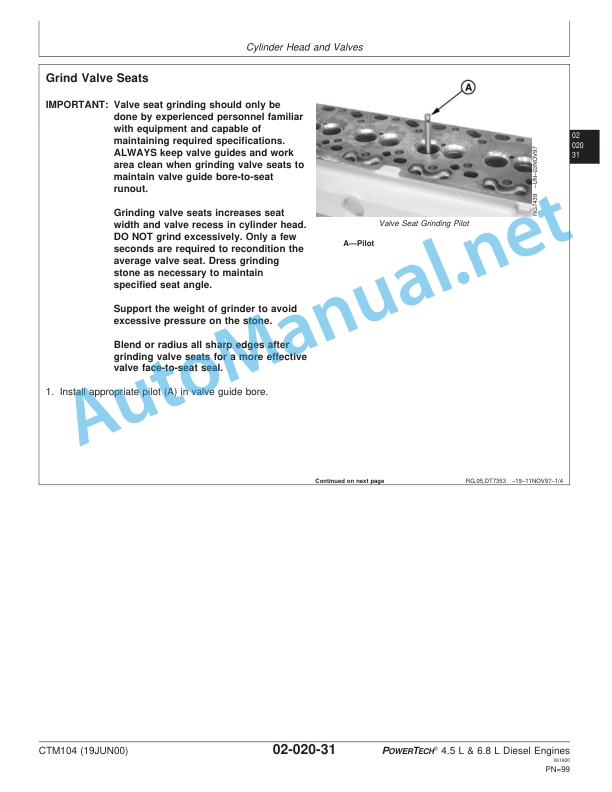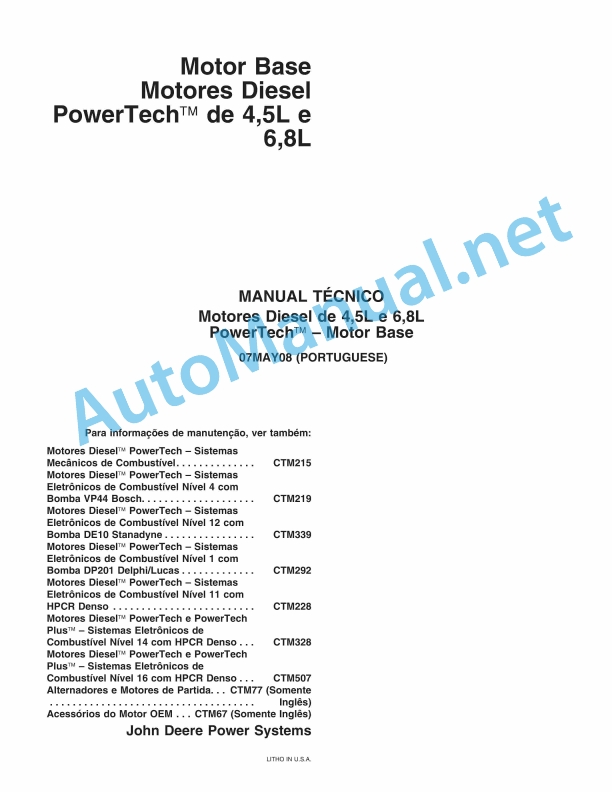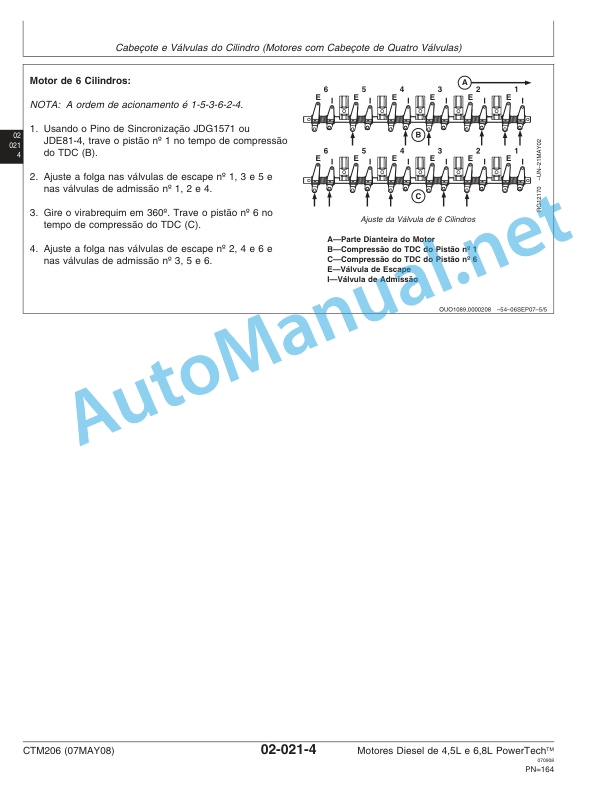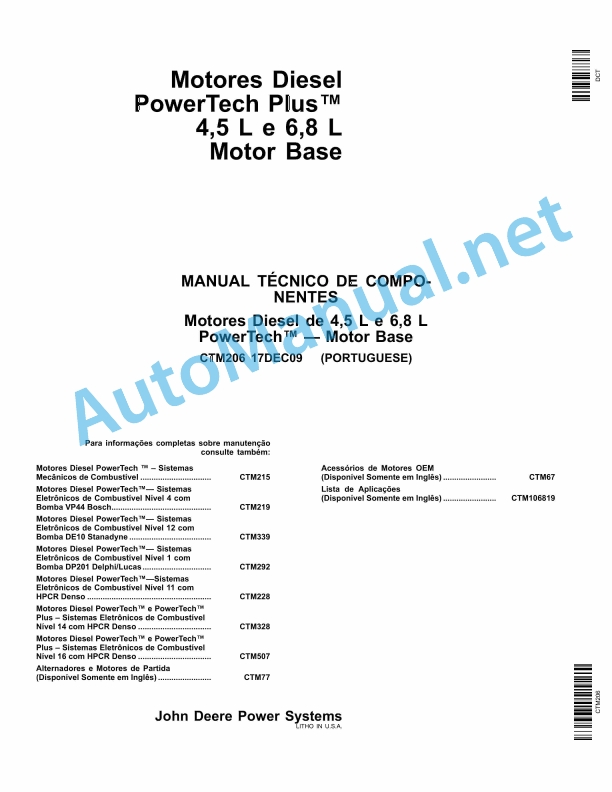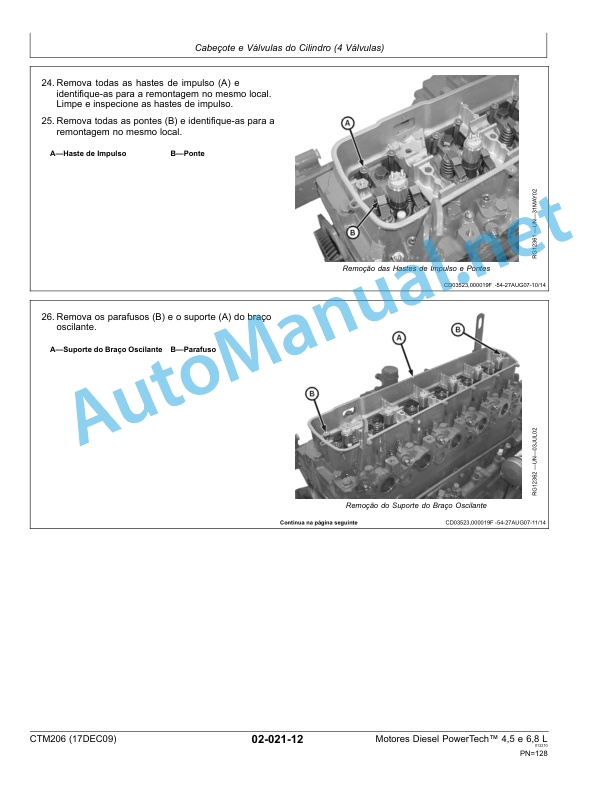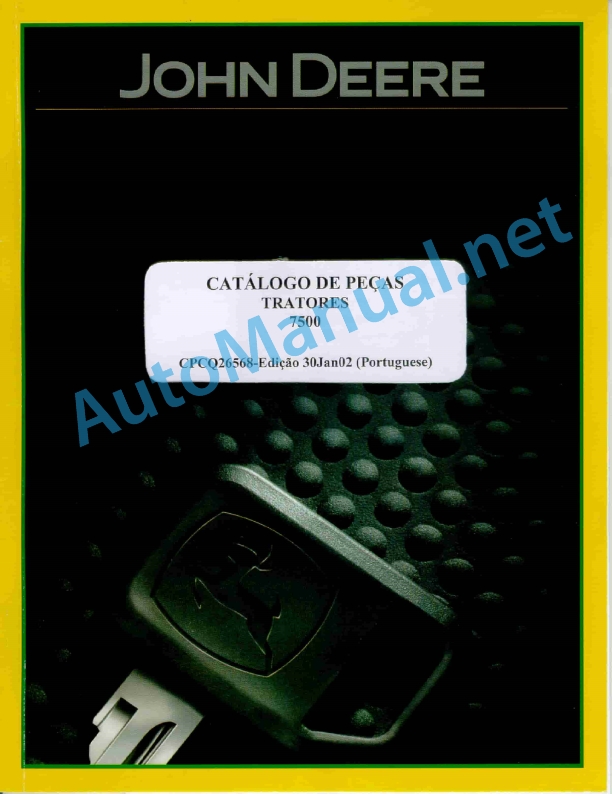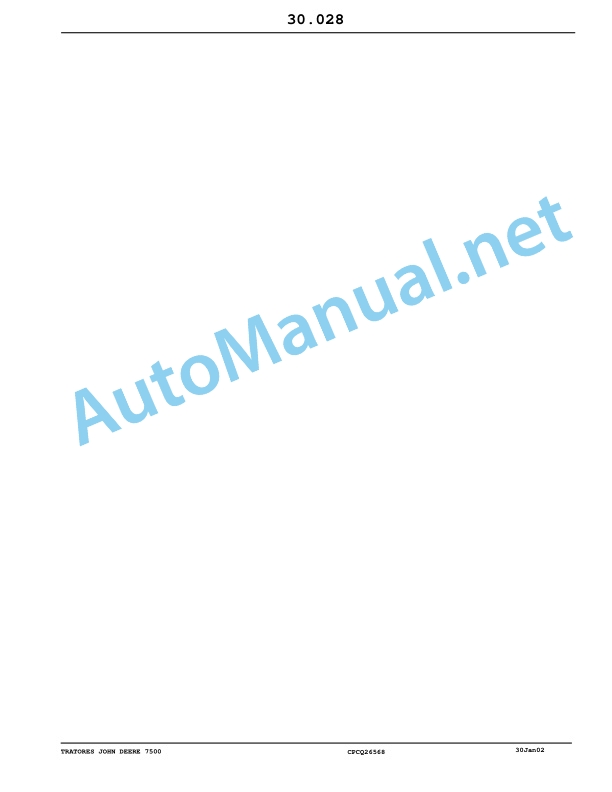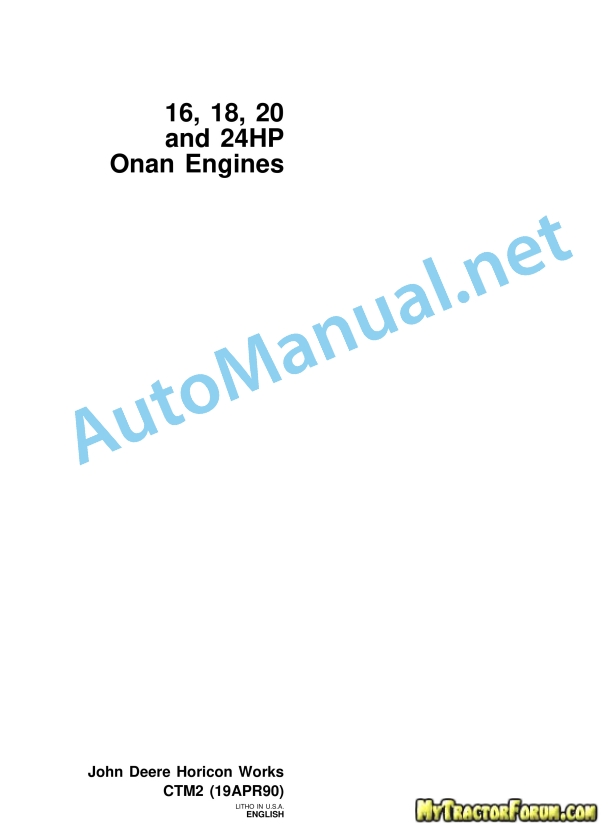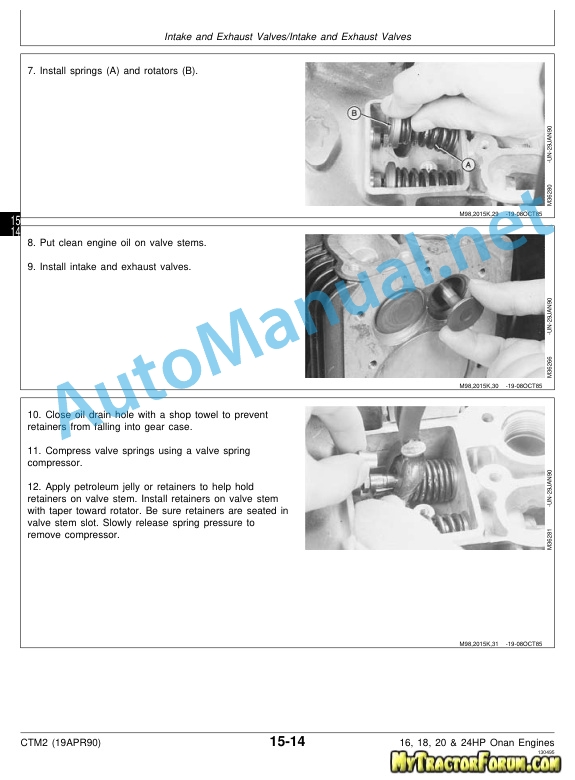Claas Quadrant 2200 Rc (735) Balers Operator Manual EN
$50.00
- Model: Quadrant 2200 Rc (735) Balers
- Type Of Manual: Operator Manual
- Language: EN
- Format: PDF(s)
- Size: 41.6 MB
File List:
00 0294 233 0.pdf
00 0297 174 0.pdf
00 0301 051 0.pdf
00 2348 408 0.pdf
00 2348 427 0.pdf
00 0294 233 0.pdf:
Introduction
Introduction
General notes
Road traffic regulations
Important note
Identification plate / serial number
Identification plate
Baler serial number
Safety rules
Safety rules
Marking of warning and danger notes
Correct use of baler
General safety and _x0004_accident prevention regulations
Trailed appliances
PTO operation (PTO operated implements only)
Hydraulic system
Tyres / Brakes
Maintenance
Noise level of machines at work, information D
Hydraulic emergency brake
Connection
Safety decals with pictorials
Specifications
CLAAS Quadrant 2200 / 2200 RC / 2200 RC HD / 2200 FC
CLAAS Quadrant 2200 / 2200 RC / 2200 RC HD / 2200 FC
Safety features
Description and function
Machine overview
Power transmission
Free wheelg sli Mechanical flywheel brake
Hydraulic flywheel brake (option)
Swath spreader (optional)
Roller crop press (optional)
Short crop baffle (optional)
Cutting facility (QUADRANT 2200 RC)
Cutting facility (QUADRANT 2200 FC)
Turbo plate (optional)
Feed rake drive
Rotor drive
Ram and baling channel
Moisture sensor (optional)
Baling pressure control
Baling pressure overload protection
Tying mechanism
Knotter cleaning unit (standard)
Turbofan (optional)
Hydraulics block
Bale chute, two-piece
Hydraulic bale chute, single piece (option from serial-no. 73501657)
Bale output sensor (optional)
Bale ejector (option)
Two-way valve
Central lubrication system
Central lubrication system (optional)
Brake anti locking system ABS (option)
Steered tandem axle (option from serial-no. 73501657)
Before operation
Check and observe the following before operating the machine
Hitching up the baler
Universal drawbar adjustment
Hitch eye adjustment from machine no. 73501417
Converting the drawbar from top (jaw type) to bottom (swinging drawbar) hitching and vice versa
Drawbar for USA
Hitch eye adjustment
Height adjustment of the hitch eye (with swivel hitch eye)
Hitching up the baler
Retracting the jack stand
Attaching the safety wire rope (Up to machine no. 73501326)
Fitting the universal drive shafts
Connecting the universal drive shaft to the baler
Fitting the universal drive shaft to the tractor
Swashing range and clearance area
Shortening the universal drive shaft
Refitting the starprofiled tube lubricating device
Modification procedure (Male guard / female starprofiled tube – on baler)
Modification procedure (Centre support of the guard)
Modification procedure (Female guard – on tractor)
Preventing the propshaft at the protection funnel from rotating with the drive shaft
Air operated brakes
Hydraulic emergency brake
Connection
Maneuvering the baler without air operated brake
Hydraulic braking system
Electrical system
Control Terminal
CLAAS COMMUNICATOR
Central terminal compartment
12 volt socket
Roller chute
Bale chute locking device
Hydraulic bale chute (option from serial-no. 73501657)
Pickup gauge wheels
Before transporting the baler
Baler set up
Pick-up height adjustment
Adjusting the working height of the pick up
Pick up with gauge wheels
Gauge wheels
Pick up crop guard with short crop baffle
Adjusting the roller crop press
Roller crop press and swath distributor
Raising the bale chamber bottom
Cutting device (RC)
Removing knives RC and FC:
Dummy knife holder (optional)
Dummy blades
Adjusting two-piece bale chute
Adjusting the hydraulic bale chute (option)
Twine boxes
Thread up the twine
Adjusting twine run
Starting work
Guide to pressure settings
Free wheeling slip clutch
Feed rake overload
Rotor overload
Electrical twine monitor
Bale ejector (option)
Lifting/lowering the bale chute
Turbofan (Option)
Hydraulic flywheel brake (option)
Emergency controls (QUADRANT 2200 to machine no. 73501416 QUADRANT 2200 RC to machine no. 73501266)
Controls for emergency operation
Setting the baling pressure
Setting the bale length
Discharging bales
Engaging and disengaging knives
Opening and closing the cutting floor
Emergency operation (QUADRANT 2200 with CLAAS COMMUNICATOR)
Control Terminal
Control Terminal – overview
Setting the bale length
Setting the baling pressure
Adjusting the bale shape (option)
Operator settings
Select the operator settings submenu
Using the operator settings
Setting the knotter cleaning (air blast) time
Length of knotter air blast time
Setting the lubrication interval
Knife cleaning
Language selection
Bale length correction factor
Display readings in the various languages
Daily and total counter
Resetting the maintenance schedule display
Resetting the daily counter
Special counter
Starting the special counter
Bale counter correction
Resetting work records
Fault display
Decreasing or increasing the pressure
Starting manual tying
Engaging and disengaging knives
Raising and lowering of the cutting floor
Starting the lubrication system manually
CLAAS COMMUNICATOR
CLAAS COMMUNICATOR – overview
Switching on the Claas Communicator
Keys and incremental encoder
Incremental encoder
Application menu
Application menu screen :
Setup menu
Counter menu
Fault menu
System information menu
Settings in the application menu
Setting the bale length
Setting the baling pressure
Selecting a job
Operator settings
Opening the adjustment menu
Setting the bale length
Bale length correction factor
Setting the baling pressure
Setting the knotter cleaning time
Activating the cutting blade sequence
Setting the lubrication interval (Claas Communicator without and with ISOBUS)
Manually controlled lubrication (Claas Communicator with ISOBUS)
Opening the counter menu
Selecting job orders
Resetting the order (zero setting)
Resetting the daily counter
Resetting the service display
Fault display
Tying fault (Claas Communicator without ISOBUS)
When starting the Claas Communicator
During work
Tying fault (Claas Communicator without ISOBUS)
Tying fault 26
Tying fault 27/28/29
Service menu
Opening the service menu
Image adjustment menu
Changing the contrast of the screen
Opening the time and date menu
Setting time/date
Opening the memory management menu
Deleting memory
Opening the language selection menu
Setting the language selection menu
Opening the Aux. menu
Building up/relieving the baling pressure
Starting manual wrapping
Swivelling cutting blades in/out
Cutting frame up/down
Controlling manual lubrication (Claas Communicator with ISOBUS)
After operation
Unhitching the baler
Parking brake
Wheel chocks
Jack stand
Uncouple the hydraulic oil hoses from the hydraulic brakes
Electrical connections
Disconnecting the air hoses
Storage of universal drive shaft
Cleaning the baler
Structure and interior of baler
Piston rod
Maintenance
Important maintenance instructions
Important maintenance instructions and safety regulations
Maintenance schedule
Lubricants chart
Brake system
Air operated brakes
Drain air reservoir
Brake cylinder
Adjusting the brake lever
Hydraulic braking system
Brake cylinder
Adjusting the brake lever
Brake linings
Brake anti locking system (ABS) (option)
Draining water from the air reservoir for the ABS
Check tight fit of wheel nuts
Checking wheel hub backlash
Adjusting the backlash
Hydraulic system
Check oil level
Oil change
Changing the hydraulic oil filter
Main gearbox
Gearbox – hydraulic pump drive
Transfer gearbox – rotor / feed rake drive
Upper gearbox – rotor drive
Lower gearbox – rotor drive
Gearbox – knotter drive
Overload clutches and shear bolts
Free wheeling slip clutch
Main drive
Pick-up drive
Knotter shaft drive
Tying release, checking and adjustment
Drive chains
Tensioning the drive chain for the pick-up drive
Tensioning the drive chain for the feed auger
Adjusting the springs of the twine retainers
Adjusting the springs of the knotter hooks
Knotter shaft brake
Adjusting the knotter pinion for correct play
Needle carrier brakes
Knotter cleaning unit (standard)
Servicing the air filter
Changing the filter cartridge
V-belt tension (up to serial-no. 73502778)
Checking the compressor console is secure (up to serial-no. 73502778)
Checking the oil level of the compressor (up to serial-no. 73502778)
Changing the compressor’s oil (up to serial-no. 73502778)
Draining water from the air reservoir for the knotter cleaning
Turbofan (Option)
Check oil level
Oil change
Changing the hydraulic oil filter
Test accumulator
Depressurising the system
Basic setting
Setting the drives to the timing marks
Tying mechanism
Adjusting knotter shaft and needles
Adjusting the needle height:
Adjusting the top dead centre position of needles:
Checking the needle position relative to the ram
Fine tuning via tying gear
Correct the adjustment via the universal shaft:
Checking inside the bale chamber
Setting the ram stop:
Twine fingers
Adjusting the twine fingers:
Lifting up the baler
Clearing a blockage in the baler
Instructions for use to avoid blockage
How to clear a blockage
Blockage of the pick-up
Blockage of screw
Normal blockage
Extensive blockage
Blockage of the feed rake
Blockage of the rotor
Proposals for winter storage
Central lubrication system
Central lubrication system (Extra equipment)
Central lubrication system with automatic pump
Filling the grease container
Filling by means of grease gun
Filling the container with a charge pump
Filling the grease container
Start the central lubrication system manually
Central lubrication by handlever-type grease gun
Filling the handlever-type grease gun
Renewing grease lines
lnstalling grease lines
Lubrication chart
Lubricants and notes
Problems, cause and remedy
Problems, cause and remedy
00 0301 051 0.pdf:
PROFI CAM 3
Table of contents
1 Introduction
1.1 Notes on the manual
1.1.1 Validity of manual
1.1.2 Information about this Operator’s Manual
1.1.3 Symbols and notes
1.1.4 Optional equipment
1.1.5 Qualified specialist workshop
1.1.6 Maintenance information
1.1.7 Warranty notes
1.1.8 Spare parts and technical questions
1.2 Intended use
1.2.1 Intended use
1.2.2 Reasonably foreseeable misuse
2.1 Identifying warnings
2.1.1 Hazard signs
2.1.2 Signal word
2.2 Safety rules
2.2.1 Meaning of Operator’s Manual
2.2.2 Observing safety decals and warnings
2.2.3 Optional equipment and spare parts
3 Product description
3.1 Overview and method of operation
3.1.1 How the PROFI CAM works
3.2 Identification plates and identification number
3.2.1 Position of identification plates
3.2.2 Explanation of PROFI CAM identification plate
3.3 Information on the product
3.3.1 CE marking
4 Operating and control elements
4.1 Camera system
4.1.1 Camera system monitor
4.2 Menu structure
4.2.1 Main menu
4.2.2
4.2.3
4.2.4
4.2.5
4.2.6
5 Technical specifications
5.1 PROFI CAM
5.1.1 Monitor
5.1.2 Camera
5.1.3 Switch box
5.1.4 Degree of protection against foreign bodies and water
6 Preparing the product
6.1 Shutting down and securing the machine
6.1.1 Switching off and securing the machine
6.2 Prior to operation
6.2.1 Carry out prior to operation
6.2.2 Installing the sun protection
6.2.3 Aligning the camera
6.2.4 Connecting the camera electrics
7 Operation
7.1 Monitor
7.1.1 Switching on the monitor
7.1.2 Calling up the menu
7.1.3 Setting a menu item
7.1.4 Setting the image orientation
7.1.5 Setting automatic screen darkening
7.1.6 Image mirroring
7.1.7 Setting the trigger view
7.1.8 Setting the follow-up time for trigger view
7.1.9 Setting the display mode
7.1.10 Activating/deactivating a display mode
8 Faults and remedies
8.1 Electrical and electronic system
8.1.1 Overview of problems on PROFI CAM camera system
8.1.2 Replacing the switch box fuse
9 Maintenance
9.1 Maintenance intervals
9.1.1 Every 10 operating hours or daily
9.2 Camera system
9.2.1 Checking the camera system for dirt
9.2.2 Cleaning the camera
9.2.3 Cleaning the switch box
9.2.4 Cleaning the monitor
10 Placing out of operation and disposal
10.1 General Information
10.1.1 Putting out of operation and disposal
11 Technical terms and abbreviations
11.1 Abbreviations
11.1.1 Units
11.1.2 Abbreviations
11.1.3 Technical terms
00 2348 408 0.pdf:
Table of contents
1 Introduction
1.1 General information
1.1.1 Validity of the manual
1.1.2 Information about this Operator’s Manual
1.1.3 Symbols and notes
1.2 Intended use
1.2.1 Intended use
1.2.2 Reasonably foreseeable misuse
2.1 Safety rules
2.1.1 General safety and accident prevention regulations
2.1.2 Interaction between terminal and machine or tractor
2.1.3 Electrocution by electrical system
3 Product description
3.1 Overview and method of operation
3.1.1 Overview of CEMIS 100
3.1.2 Function principle of CEMIS 100
3.2 Identification plates and identification numbers
3.2.1 Spare parts and technical questions
3.2.2 Identification plate of CEMIS 100
4 Operating and display elements
4.1 CEMIS 100
4.1.1 User interface for LINER
4.1.2 User interface for ROLLANT
4.1.3 User interface for UNIWRAP
5 Technical specifications
5.1 CEMIS 100
5.1.1 Specification
6 Operation
6.1 CEMIS 100
6.1.1 Operating the CEMIS 100
6.1.2 Switching CEMIS 100 on
6.1.3 Switching CEMIS 100 off
7 Maintenance
7.1 CEMIS 100
7.1.1 Daily
8 Putting out of operation and disposal
8.1 General information
8.1.1 Removal from service and disposal
9 Technical terms and abbreviations
9.1 Terms and explanations
9.1.1 Technical words
9.1.2 Abbreviations
00 2348 427 0.pdf:
Table of contents
1 Introduction
1.1 General information
1.1.1 Validity of the manual
1.1.2 Information about this Operator’s Manual
1.1.3 Symbols and notes
1.2 Intended use
1.2.1 Intended use
1.2.2 Reasonably foreseeable misuse
2.1 Safety rules
2.1.1 General safety and accident prevention regulations
2.1.2 Interaction between terminal and machine or tractor
2.1.3 Electrocution by electrical system
3 Product description
3.1 Overview and method of operation
3.1.1 Overview of CEMIS 700
3.1.2 Function principle of CEMIS 700
3.2 Identification plates and identification numbers
3.2.1 Spare parts and technical questions
3.2.2 Identification plate of CEMIS 700
4 Information on the product
4.1 Software version
5 Operating and display elements
5.1 CEMIS 700
5.1.1 User interface
5.1.2 Terminal program
6 Technical specifications
6.1 CEMIS 700
6.1.1 Specification
7 Operation
7.1 CEMIS 700
7.1.1 Operating the CEMIS 700
7.1.2 Switching CEMIS 700 on
7.1.3 Switching CEMIS 700 off
7.2 Terminal settings
7.2.1 Making settings
Making settings with the rotary button
Making settings with the touch function
7.2.2 Setting the screen lighting
Daytime mode
Nighttime mode
Activating automatic key lighting
7.2.3 Setting the time and date
7.2.4 Displaying diagnosis information
On-board power supply voltage display
Display of CLAAS ISOBUS ECU address and name
7.2.5 Setting the language and display formats
Setting the language
Setting display formats
7.2.6 Setting the volume
7.2.7 Deleting an ISOBUS implement
8 Maintenance
8.1 Maintenance
8.1.1 Daily
9 Putting out of operation and disposal
9.1 General information
9.1.1 Removal from service and disposal
10 Technical terms and abbreviations
10.1 Terms and explanations
10.1.1 Technical words
10.1.2 Abbreviations
John Deere Repair Technical Manual PDF
John Deere Repair Technical Manual PDF
John Deere Repair Technical Manual PDF
John Deere Diesel Engines POWERTECH 2.9 L Component Technical Manual CTM126 Spanish
John Deere Repair Technical Manual PDF
John Deere Transmission Control Unit Component Technical Manual CTM157 15JUL05
John Deere Repair Technical Manual PDF
John Deere Repair Technical Manual PDF
John Deere Diesel Engines PowerTech 4.5L and 6.8L – Motor Base Technical Manual 07MAY08 Portuguese
John Deere Repair Technical Manual PDF
John Deere Parts Catalog PDF
John Deere Tractors 7500 Parts Catalog CPCQ26568 30 Jan 02 Portuguese
John Deere Repair Technical Manual PDF
John Deere Repair Technical Manual PDF
John Deere 16, 18, 20 and 24HP Onan Engines Component Technical Manual CTM2 (19APR90)
